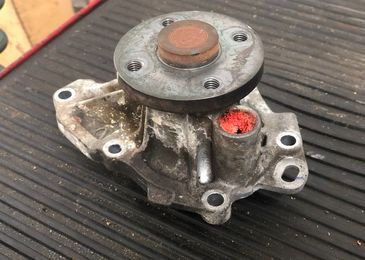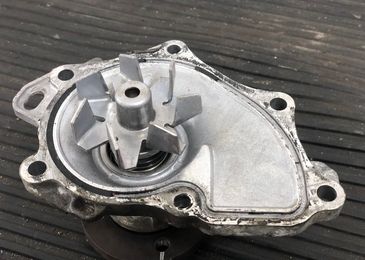We don’t cook in traffic jams: how to prevent a car engine from overheating
- March 25, 2023
- 0
It’s getting warmer outside: the summer season is upon us, and so are the “ten point” May traffic jams – let’s start cooking! A passionate desire to save
It’s getting warmer outside: the summer season is upon us, and so are the “ten point” May traffic jams – let’s start cooking! A passionate desire to save

It’s time for summer – there is already a stable “plus” on the street, seedlings are in full swing on the windowsills. It’s time to prepare the car for the hot season! Mounting tires alone is not enough: you need to check the oil and service the brakes, which often turn sour after winter, not to mention the fluid, and of course “visit” the cooling system. It is she who from year to year becomes the culprit of numerous traffic jams on Fridays, when cars begin to boil en masse.
There are many reasons for this: a “dead” thermostat, leaky hoses, a “tired” pump. Often the worthless antifreeze that enters the system at the behest of an unwary car owner or an illiterate master is also to blame. However, if a problem with the hoses can be detected with the eyes and an indicator on the dashboard or a jump in fuel consumption will signal a thermostat failure, then everything is a bit more difficult with a pump.
In general, this is the simplest device, which is a “water wheel” driven by a belt with additional equipment. Well, what could be difficult there? As drivers in garages say, if it leaks, replace it. In addition, all regulations say that the life of the pump is 60,000 to 90,000 km. Usually a new timing belt goes with it – because it has to be taken off and is disposable.
However, it does not always come to a leak: first the pump starts to rattle, because as the rubber seals wear out, antifreeze gets on the bearings. By turning the music down a bit, this sound is clearly audible. The second important point is the backlash of the pulley. If any doubts have crept in, you can shake the roller with your hand without even removing the belt. It is not easy to achieve, but it is possible: the minimum “displacement” indicates that the pump has “arrived”. With your eyes you can also see the third point: misalignment, that is, a crooked roll relative to other nodes. It sounds complicated, but in fact it’s simple: it has to run parallel to the motor, otherwise writing is wasted.
In point four – stains and even the smell of antifreeze. If these are located, do not hesitate to order a part. An experienced driver can afford another “measurement” – uneven heating of the engine – sharp movements of the arrow on the instrument scale. A little more than others, Toyota owners were lucky: the manufacturer made a special drain for coolant entering the bearings, which is actually an indicator. If red foam appears, it’s time to sign up for a service.
Why does wear and tear occur? The main point is the quality of the fluid and the frequency of its replacement. Precipitation of various types of precipitation, improper composition of antifreeze, a clogged radiator and much more drastically reduce the life of the pump. And the life expectancy and operation of the most expensive unit of a car – the engine – directly depend on its work. In general, the risk is not justified – it is absolutely not worth saving on cooling system maintenance.


It’s time for summer – there is already a stable “plus” on the street, seedlings are in full swing on the windowsills. It’s time to prepare the car for the hot season! Mounting tires alone is not enough: you need to check the oil and service the brakes, which often turn sour after winter, not to mention the fluid, and of course “visit” the cooling system. It is she who from year to year becomes the culprit of numerous traffic jams on Fridays, when cars begin to boil en masse.
There are many reasons for this: a “dead” thermostat, leaky hoses, a “tired” pump. Often the worthless antifreeze that enters the system at the behest of an unwary car owner or an illiterate master is also to blame. However, if a problem with the hoses can be detected with the eyes and an indicator on the dashboard or a jump in fuel consumption will signal a thermostat failure, then everything is a bit more difficult with a pump.
In general, this is the simplest device, which is a “water wheel” driven by a belt with additional equipment. Well, what could be difficult there? As drivers in garages say, if it leaks, replace it. In addition, all regulations say that the life of the pump is 60,000 to 90,000 km. Usually a new timing belt goes with it – because it has to be taken off and is disposable.
However, it does not always come to a leak: first the pump starts to rattle, because as the rubber seals wear out, antifreeze gets on the bearings. By turning the music down a bit, this sound is clearly audible. The second important point is the backlash of the pulley. If any doubts have crept in, you can shake the roller with your hand without removing the belt. It is not easy to contact, but it is possible: the minimum “displacement” indicates that the pump has “arrived”. With your eyes you can also see the third point: misalignment, that is, a crooked roll relative to other nodes. It sounds complicated, but in fact it’s simple: it has to run parallel to the motor, otherwise writing is wasted.
In point four – stains and even the smell of antifreeze. If these are located, do not hesitate to order a part. An experienced driver can afford another “measurement” – uneven heating of the engine – sharp movements of the arrow on the instrument scale. A little more than others, Toyota owners were lucky: the manufacturer made a special drain for coolant entering the bearings, which is actually an indicator. If red foam appears, it’s time to sign up for a service.
Why does wear and tear occur? The main point is the quality of the fluid and the frequency of its replacement. Precipitation of various types of precipitation, improper composition of antifreeze, a clogged radiator and much more drastically reduce the life of the pump. And the life expectancy and operation of the most expensive unit of a car – the engine – directly depend on its work. In general, the risk is not justified – it is absolutely not worth saving on cooling system maintenance.
Source: Avto Vzglyad
Donald Salinas is an experienced automobile journalist and writer for Div Bracket. He brings his readers the latest news and developments from the world of automobiles, offering a unique and knowledgeable perspective on the latest trends and innovations in the automotive industry.